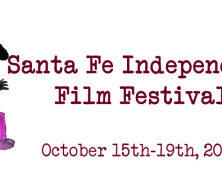Jackalope Magazine interviews actor and author Felicia Day in advance of her Sept. 13 booksigning in Santa Fe, NM.
SFIFF Student Shorts
posted by Charlotte Martinez
SFUAD student filmmakers discuss their work showing at the Santa Fe Independent Film Festival Oct. 17.
Ready, Set, SFIFF
posted by Charlotte Martinez
“The best short films are student shorts,” says Jacques Paisner, executive director and co-founder of the Santa Fe Independent Film Festival. In its fourth year, the festival’s four-day event, Oct. 16-20, will be held at the Center for Contemporary Arts (CCA), Lensic Performing Arts Center, The Screen, and the newly opened Jean Cocteau Cinema in downtown Santa Fe. Dedicated to screening independent films, Paisner shares that a good amount of the festival’s 2013 submissions, as of March 1, came from the student population. Filmmakers, like those from SFUAD’s Film School are provided resources, “great equipment,”as Paisner puts it, which allows for the ideal collaboration experience. “If you’re in directing class…you’ll work with a writer from the writing class and that creates a really good short film,” he says. Furthermore, the shorts can act as a “calling card” because, according to Paisner, the festival circuit is one of the only places students gain exposure. It is here they can say,”‘look I’m a student filmmaker, collaborate with me.” For two of SFUAD’s own film students, the Santa Fe Independent Film Festival was a tremendous opportunity to expose their work. “We were planning on entering the festival before we shot the film,” says SFUAD film major Seth Fuller, whose film U46-Anomaly (Anomaly in the SFIFF listings) will be screened for the SFIFF at 9 p.m., Oct. 16 at the CCA. “We went into it trying to make it as polished as possible, to be a product to showcase what we are capable of. With that being said, we wanted to focus on the local community first since we are local filmmakers.” Fuller’s 13-minute short, shot last year in collaboration with New Mexico local Scott Hussion (producer) and fellow student Emmett Meade (producer/editor), is categorized as a sci-fi drama and...
The Screen Goes Digital
posted by Charlotte Martinez
“It’s all George Lucas’ fault,” says Peter Grendle, the Screen’s cinematheque manager, dispensing news of the world’s steady conversion of film projection to digital projection. According to Grendle, when director George Lucas filmed the last of his famous Star Wars episodes from 2002-2005, he loathed the idea of his precious turn-of-the-century movies going up on what Grendle calls the “shitty mall theaters” (whose projectionists pay little attention to presentation). Determined to get the best possible picture, Lucas shot Attack of the Clones and Revenge of the Sith in 100 percent high definition and premiered them in select theaters using digital projectors. Even if the mall theaters failed Lucus, at least the final prequels were forever in high definition. Since then, filmmakers have followed George Lucas, the “father of digital cinema,” into the inevitable future of digital. Hence, the annihilation of film! That’s a bit dramatic. Hence, movie company’s slow change from film to affordable new age cinema. And, for better or worse, the Screen, part of the 10 percent of theaters still capable of 35mm film projection, has finally gotten the boot: its 35mm projectors are retiring. A digital cinema package (DCP) will take their place. “We’ve been essentially an all blue ray theater for the past year,” Grendle says, “we do as many 35mm [films] as possible…but we have to [install] digital if we actually want to play movies. Otherwise the theater is just a place with, you know, great seats and a white wall.” Expert projectionist Barbara Grassia believes that the Screen’s transition is a positive change because “digital’s visual quality has been improving.” Grassia has participated in Film Festivals such as Sundance, Tribeca, Traverse City, Bermuda, the Dominican Republic, Telluride, Turner Classics, and Durango Independent Film Festival. “While the quality of 35mm presentation has been steadily declining,” Grassia says, “many multiplexes have allowed 35mm equipment to deteriorate to the point that presentation is seriously compromised.” Center for Contemporary Arts (CCA) Director Jason Silverman, who recently converted CCA’s primary film projection theater to digital, also points out that “DCP is pristine start to finish. Audio and picture quality are easily adhered to the filmmaker’s and studio’s intentions and we’re finding lots of interesting DCP content to show.” The creator and curator of the Screen, Brent Kliewer, agrees that “the benefits [of digital] will far outweigh anything negative.” He adds, “digital is where the industry is headed and to keep up we (meaning all independent theaters) must move forward.” It’s been a long time coming for the Screen, Grendle explains. Three years ago he received a letter from Fox, the high budget movie company whose films the Screen doesn’t play anyway, informing theaters that the company will no longer make 35mm prints. From there, Grendle was badgered by numerous companies to switch earlier rather than later. What was the final blow? The big companies gave in. The Regal Cinemas, a major branch of movie theaters, upgraded last year and according to Grendle, once the “big guys” convert, it means everyone else will follow. For a while, however, the 15 percent of film geeks, or independent filmmakers and theater owners, protested the digital conversion and treaded the pool of their financial difficult for the sake of saving film. “All the indies are exactly the same,” Grendle says, “They’re pushing out these small weird art movies for a small weird art crowd in small weird art theaters.” He explains that the Screen, like the CCA and newly opened Jean Cocteau in Santa Fe, was founded on “a love for film.” Furthermore, Brent Kliewer, original founder of all three respected cinematheques, is himself a “film junky,” a believer in projection and acoustic perfection. The Screen, for example, was built on an old soundstage and the 35mm projector bulbs burn so bright that they’re moved away from the body of the projectors so the film doesn’t burn. Regarding the art of film projection verses digital, Grendle...





 Jackalope Magazine is the student magazine of Santa Fe University of Art and Design. Building on the interdisciplinary nature of our education, we aim to showcase the talent of our university and character of our city.
Jackalope Magazine is the student magazine of Santa Fe University of Art and Design. Building on the interdisciplinary nature of our education, we aim to showcase the talent of our university and character of our city.
Recent Comments